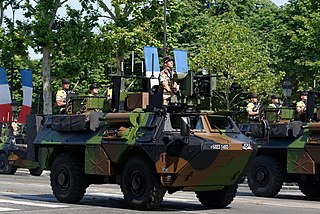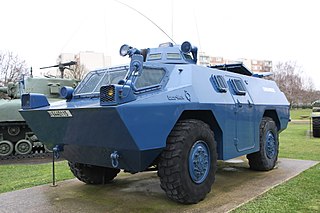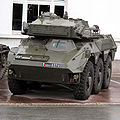
Renault Trucks is a French commercial truck manufacturer with corporate headquarters at Saint-Priest near Lyon. Originally part of Renault, it has been a subsidiary of the Volvo Group since 2001.

The Véhicule de l'Avant Blindé or VAB is a French armoured personnel carrier and support vehicle designed and manufactured by Renault Trucks Defense. It entered service in 1976 and around 5,000 were produced. It has seen combat in various conflicts in Africa, Asia as well as Europe and has also been exported to more than 15 countries.

The Panhard ERC is a French six-wheeled armoured car which is highly mobile and amphibious with an option of being NBC-proof. While various models were tested, only two versions of the ERC entered production in large numbers: the ERC-90 Lynx and the ERC-90 Sagaie. The main difference between the two versions is the type of turret and 90 mm gun fitted. Sagaie is French for assegai, a type of African spear.

The Panhard AML is a fast, long-ranged, and relatively cheap armoured car with excellent reconnaissance capability. Designed on a small, lightly armoured 4×4 chassis, it weighs an estimated 5.5 tonnes, and is thus suitable for airborne deployment. Since 1959, AMLs have been marketed on up to five continents; several variants remained in continuous production for half a century. These have been operated by fifty-four national governments and other entities worldwide, seeing regular combat.

The Ferret armoured car, also commonly called the Ferret scout car, is a British armoured fighting vehicle designed and built for reconnaissance purposes. The Ferret was produced between 1952 and 1971 by the UK company Daimler. It was widely used by regiments in the British Army, as well as the RAF Regiment and Commonwealth countries throughout the period.

The AMX-10P is a French amphibious infantry fighting vehicle. It was developed after 1965 to replace the AMX-VCI in service with the mechanized regiments of the French Army; the first prototypes were completed in 1968. Production commenced between 1972 and 1973.

The Véhicule Blindé de Combat d'Infanterie or VBCI is a French Infantry fighting vehicle designed and manufactured by GIAT Industries and Renault Trucks Defense to replace the AMX-10P. The first units entered active service with the French Army in 2008. 630 units were ordered and full delivery was completed in 2018. Spain and the UK have notably shown interest in acquiring the vehicle but ultimately opted for domestic options instead.
ACMAT is a French manufacturer of cross-country and tactical military vehicles since 1958. Known for their reliability, simplicity, ruggedness and their 80% commonality of parts across the entire product line, these vehicles were originally targeted at African and Asian countries who could not afford more expensive vehicles. The ACMAT company built their vehicles based on standardisation, commonality of parts and components, and on interchangeability; parts are interchangeable with vehicles built 30 years ago. Parts commonality includes cabs, structural components, engines and drive trains. ACMAT uses many of the same parts for all of its line of vehicles. They even produce an armoured variant of both the 4x4 and 6x6 versions of the VLRA.

The Berliet VXB-170 is a four-wheel armoured vehicle used primarily as an internal security vehicle. Developed and initially produced by Berliet until Berliet was merged with Saviem to form Renault Trucks, it lost to the Saviem VAB the competition to equip the French Army, even though it was cheaper than its competitor. Production stopped after fewer than 200 vehicles had been produced.

The Panhard M3 VTT is an amphibious armoured personnel carrier. Developed as a private venture for the export market, the M3 was built with the same mechanical and chassis components as the Panhard AML range of light armoured cars. The two vehicle types share a 95% interchangeability of automotive parts. The M3 is an extremely versatile design which can be configured for a wide variety of auxiliary battlefield roles. The most popular variants of the base personnel carrier included an armoured ambulance, a mobile command post, and an internal security vehicle. It could also be fitted with a wide variety of turrets and armament, ranging from a single general-purpose machine gun to medium calibre autocannon.

The WZ-523 is a six-wheeled Chinese armored personnel carrier designed to be amphibious. Built on the chassis of the Hanyang HY472 truck, it can carry a crew of three and seat up to eight additional passengers. Two primary models were produced—one with a roof-mounted 12.7mm heavy machine gun, and the other with a small turret armed with a 35mm grenade launcher and a 7.62mm co-axial general purpose machine gun. An export model that entered service in 2008 as a fire support vehicle was also marketed successfully to the Namibian Army; this is armed with a 73mm 2A28 Grom smoothbore cannon in exactly the same turret as used on the Soviet BMP-1 infantry fighting vehicle.

The Aravis is an infantry mobility vehicle developed and built by French company Nexter. An order for 15 Aravis vehicles was placed by the Délégation Générale pour l'Armement in April 2009 for use by the French Army as a reconnaissance and escort vehicle for engineer units. Deliveries for the initial order began in January 2010.

The Royal Guard of Oman (RGO) is the royal guard of the Sultan of Oman. It is a separate service within the Sultan's Armed Forces (SAF) and although equipped to carry out land defense operations, it is not part of the Royal Army of Oman. The RGO is a personal security and ceremonial unit responsible for the protection of the Sultan and other senior members of the Royal Family.
The Société de Véhicules Automobiles de Batilly (SoVAB) is a subsidiary of the French car manufacturer Renault, created in 1980 to operate the light commercial vehicle plant located at Batilly.

The ATOM is a heavy 8×8 infantry fighting vehicle (IFV) jointly developed by the Russian company Petrel and the French company Renault Trucks. The vehicle is established on the basis of the French Véhicule blindé de combat d'infanterie (VBCI) IFV which is produced by Renault. The prototype of the ATOM was first unveiled during the 2013 Russian Arms Expo at Nizhny Tagil, equipped with a unique fighting module.

The Véhicule Blindé Multi-Rôle Griffon or VBMR Griffon is a French multi-purpose armoured personnel carrier developed and manufactured by Nexter in cooperation with Arquus and Thales. Entering service in 2018, it will, alongside the VBMR-L Serval, succeed the Véhicule de l'Avant Blindé (VAB).

The Engin Blindé de Reconnaissance et de Combat Jaguar or EBRC Jaguar is a French armoured reconnaissance vehicle that will replace the French Army's AMX 10 RC and ERC 90 Sagaie reconnaissance and fire support vehicles as well as the VAB Mephisto.

Pindad Badak is a 6×6 fire support vehicle designed and produced by PT Pindad. The name Badak means rhinoceros in Indonesian.

The Vehículo Anfibio de Exploración was an armored personnel carrier project developed by Argentina in the 1970s.

The Vehículo Anfibio Pesado de Exploración was a wheeled amphibious reconnaissance vehicle project developed by Argentina in the 1970s. Commissioned by the Argentine Army, two prototypes were developed by the French companies Renault and Panhard. On top of reconnaissance, the vehicle was also designed for direct infantry support and anti-tank warfare.






















